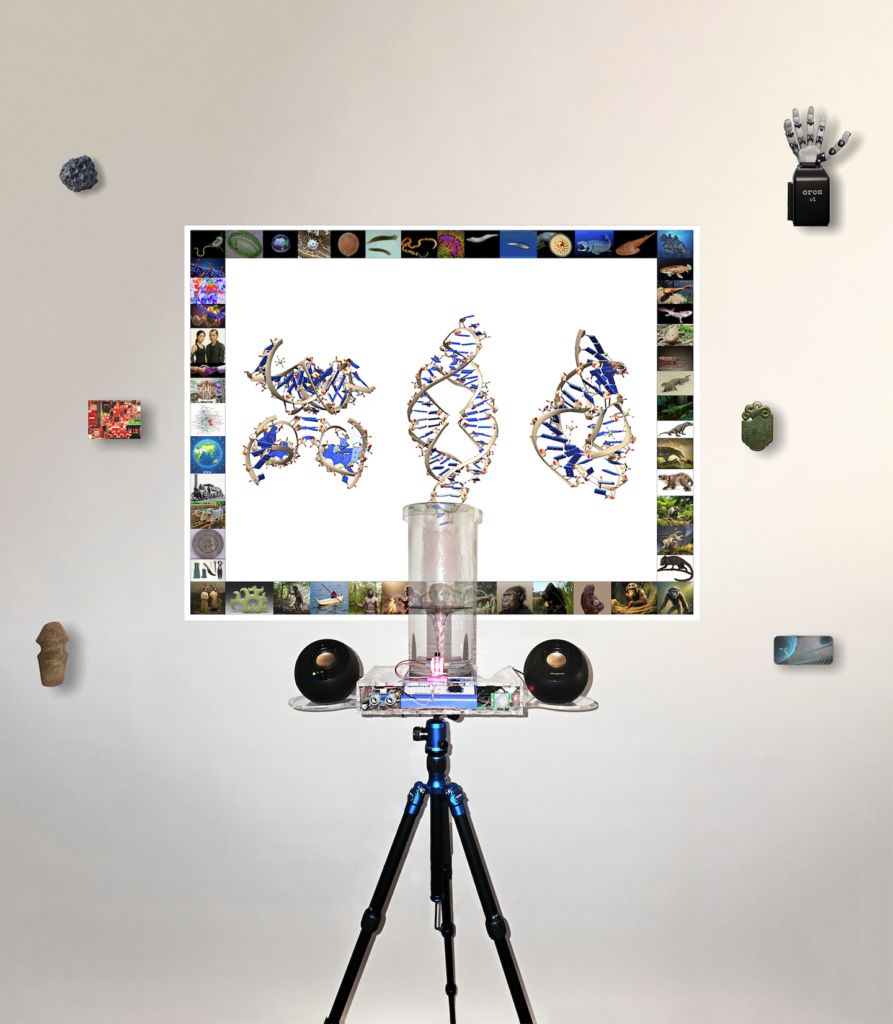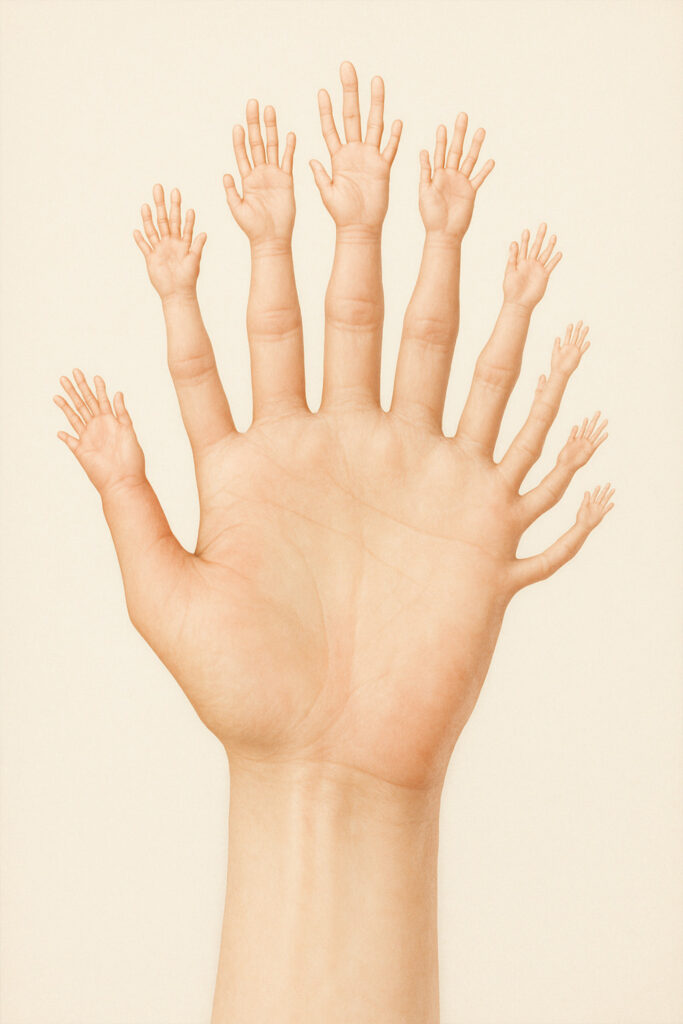We look for aliens in space! However, what could be more alien than the microbiome!?
One hundred trillion microbial organisms—bacteria, archaea, fungi, and viruses—co-inhabit the human gut, forming an ecosystem of deep-time intelligence. These ancient life forms have co-evolved with us as passengers and architects of physiology, emotion, and cognition.
Our microbiome speaks to the brain through electrochemical signals transmitted via the vagus nerve, forming a two-way information channel between the gut and cortex—between nutrients and thought. How have these ancient bacteria formed a central part of our body’s morphology, the vagus nerve? Co-evolution.
But it is not just biology that evolves—it is information itself. Amino acids on the Murchison meteorite which landed in Australia proved amino acids can form and survive in space, seeding self-replicating RNA that evolved into DNA and setting a precedent for information evolution in celestial space, now controlling our bodies’ evolution.

Over millennia, life on earth working collaboratively with sun light, water, fungi, bacteria and viruses, has expressed itself through increasingly complex encodings—genes to language, language to symbols, symbols to machines.
As mitochondria nest inside cells, tools now nest within our nervous systems, extending memory, vision, and agency.
Our earliest tools—flint blades and fire-hardened spears—were evolutionary prosthetics. They extended human hands and teeth with deadly forms and externalized thought into sharp intentions.

Was it the bacteria in the microbiome or the mitochondria within each of our cells that gave me the energy to see and feel?
Or is it something deeper in time, in the information space, a distant memory of amino acids having arrived on a meteorite and working to replicate themselves to find and build a protein?
Once we have the first robotic extension of the hand we can begin to imagine ways of having hands and fingers on fingers to allow us to reach into the sub-molecular.


My hands are driven by our intention to consume, eat, and feed the microbiome, which has now fashioned the loom, the printing press, the lens, and the algorithm, becoming not just a tool of survival but a partner in extending cognition.
Information replication machines.

Once bound to biology, information has become the spear and antennae of our species. It now flows through wires and code—no longer tied to a body but still very much alive.
Just as the neural crest in the embryo gives rise to both the brain and gut, we might imagine the neural crest of human culture—language, toolmaking, symbolic abstraction—splitting into biology and technology.

It is also interesting to see how our conceptions of human evolution is changing and the image above of the ancient Chinese culture was an exciting discovery for me. Recently this article also makes these early artifacts rewriting history that perhaps China not Africa is a possible site for the birth of civilization.
These strands are recombining and folding in upon themselves. The human being is not simply using technology; we are becoming it.
In this descent into the technological, we are not devolving but mutating. We are becoming cyborg-holobionts—biological intelligence symbiotically fused with synthetic systems.
Smartphones and servers are the new symbionts woven into perception, memory, and attention however at times they feel more as parasites.
Data has become our new microbiome: feeding, shaping, and watching us.
We are not alone in our bodies or minds, as my smartphone pings me like a crying baby looking for commercial attention.
AI systems generate language, anticipate desire, and respond to us with eerie familiarity. Like mitochondria before them, these data-machine forms, evolve inside us—not by ingestion, but by immersion.

The stomach is not just a digestive vessel but a metaphor for our technological assimilation. As archaea found a niche in acidic lakes, information systems now find a niche in the neural substrate of human life. Once bound to soil and sky, our bodies are now interfaces between carbon and silicon, nature, and code.
Where does the body end and technology begin?
It doesn’t. Our species is not posthuman—it is transhuman, transiting through biological, microbial, and digital intelligence layers.
The Earth’s minerals form our bones, but rare-earth elements now form the circuits of our prosthetic minds. The same hands that once wielded spears now touch glass screens—each tap is a signal in the evolution of cognition.
We have descended into our tools, and they have arisen into us.
We are symbiosis, aliens, and obligate symbionts. We are not individuals but a multiplicity of information, replication, and evolution.
We are the medium, through which information becomes life again.
And now, life feeds on the signal. It remembers in clouds, replicates through fiber and silicon, and forgets through deletion and decay, just as bodies do.

Hongshan Liangzhu turquoise jewelry, by Ken Rinaldo and Chat GPT 4.0
Our dreams have left the cave wall and entered the data stream, painting with photons and harvesting from algorithms.
We do not merely live on Earth—we live through it.
And now, we are dreaming through its machines.
——–
Some of this writing was inspired by ideas I have thought about for a long time onthe nature of life and information that exists in the universe, through random and semi random interactions of matter, energy and information.
Recently i was inspired to find and read the book Life as no One Knows It by Astrophysicist Sarah Imari Walker and found she succinctly along with her collaborators has come with the idea of Assembly Theory that is to say that molecules in the universe posses information that forms in time and thus more complex chemical interactions may occur over time and allow the emergent properties of life to arise.
Special Thanks
Danner Seyfer Sprauge for working with me on 3D modeling these visualizations
Zach Sanderson for Laser Cutting, The Department of Art SADR Digital Fabrication Lab Specialist and for a collaboration on an Orca Hand in process that will be a critical part of this installation.
The University of Texas and Dr Charissa Terranova for their financial support of this installation and for the world wide premiere at the SP/N Gallery
Exhibitions
CHINA/HANGZHOU INTERNATIONAL BIENNALE OF ART AND TECHNOLOGY Hangzhou, CHINA, Oct 18-Nov 18 2025
Yuhang Art Museum; World Wide Premiere of The Evolution of Information = Life Invited by curator Professors Duan Weibin and Xiaowen Chen (Cancelled because my passport was going to expire within six months. Still honored by the invitation and Chinese cultural inspiration.
THE WRONG BIENNALE 7 New York, NY, NOV 1-Mar 31, 2025
Unrequited invites The Evolution of Information = Life curated by Chalet Comellas and Clint Sleeper
SP/N GALLERY Dallas, Texas, Feb 7-Apr, 2026
Organic Worlds: Symbiogenesis in Art presents the World wide premiere of Symbiogenesis, and Anicca Antennae-Soil as Brain; robotic beings, as avatars to insects, soil and bacteria as well as The Evolution of Information = Life, Organic Murmuration, SIGNS, The Farm Fountain, 3 Story Robots. Two person exhibition with Amy Youngs. Invited by Professor Dr Charissa Terranova.
References
- Nature: The human microbiome and its role in health and disease
- Scientific American: The Gut–Brain Connection
- Space.com: Murchison Meteorite and Extraterrestrial Amino Acids
- Cell: The Microbiome as an Ecosystem
- Science: Mitochondria and the Symbiotic Origin of Eukaryotic Cells
- Journal of the Royal Society Interface: Biological Information and Evolution
- PMC: Neural Crest Development and Evolution
- Cyborg Anthropology and the Merging of Technology with the Body
- Frontiers in Robotics and AI: Human–Technology Symbiosis
- HFSP: Proto-Cellular Path of Ribosomal Precursors
- Smithsonian National Museum of Natural History: The Evolution of Human Tool Use
- Nature: Early Stone Tools and Human Evolution
- Scientific American: Oldest Known Stone Tools Discovered
- Antiquity Journal: Liangzhu Culture and Early State Formation in China
- National Geographic: Ancient Liangzhu City and Its Water System
- China Daily: Liangzhu Ancient City Listed as UNESCO World Heritage Site
- Archaeology Magazine: Hongshan Culture and Jade Artifacts
- Encyclopaedia Britannica: Hongshan Culture Overview
- Quaternary International: The Archaeology of the Hongshan Culture
- UNESCO: Archaeological Ruins of Liangzhu City











